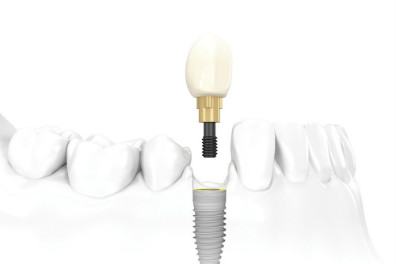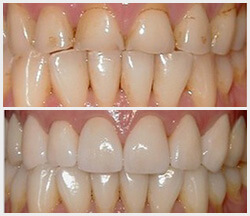What To Expect
Initial Consultation (One Day)
During the initial consultation for dental implants, your dentist or oral surgeon will assess your oral health and determine if you’re a good candidate for the dental implants. This typically includes a thorough examination of the teeth, gums, and jawbone.
Next, X-rays or other imaging tests will be taken to get a better look at your jawbone and its surrounding oral structures. This will help determine the best location for the implant and whether or not you have enough bone density to support it.
The dentist or oral surgeon will also discuss your medical history and any medications you’re currently taking, as certain medical conditions or medications can affect the success of implant treatment.
If you’re a good candidate for dental implants, your dentist will then discuss the different types of dental implants available, and explain the benefits and risks of each option. They’ll also explain the surgical procedure, recovery time, and estimated cost of the treatment.
Finally, the dentist may take measurements or dental impressions of your teeth and jaw to use while planning your implant placement.
Pre-Implant Treatment Surgeries (Dependent On Patient Situation – 3 to 12 months)
In certain cases, you may need to undergo some pre-implant treatment surgery. Also known as supplemental procedures, patients may need one depending on various factors:
- Insufficient Jawbone Density: Dental implants require a certain amount of healthy jawbone to securely anchor the posts. If you lack adequate jawbone density, a bone grafting procedure may be needed to build up the jawbone before implant surgery.
- Gum Disease: Gum disease can lead to the loss of bone and tissue in the jaw, making it difficult to place dental implants. If you have gum disease, you’ll need treatment to address the infection.
- Sinus Augmentation: When placing an implant in the upper jaw, the implant may need to be placed in the sinus area, a hollow area behind the cheekbones. In some cases, this area may not have enough bone to support an implant. A sinus augmentation procedure can add bone to the sinus area to provide enough support for the implant.
- Ridge Expansion: When the jawbone is too thin or too narrow to support an implant, a procedure called ridge expansion can be done to add width to the jawbone. This procedure is performed before or during implant placement.
Dental Implant Placement (One Day)
The specific steps of dental implant surgery may vary depending on the type of implant being used and your individual needs. Generally, the procedure is completed in the following steps:
- Anesthesia/Dental Sedation: You’ll be given local anesthesia or IV sedation to ensure you’re comfortable during the procedure and feel no pain.
- Incision: The surgeon will make a small incision in the gums to access the jawbone.
- Implant placement: The implant, which is a small metal post, is then carefully placed into the jawbone. It will be placed deep enough to ensure it’s stable and secure.
- Suture: The incision will be closed with sutures and the surgical area cleaned and dressed.
Once the implant surgery is complete, you’ll go home to begin the recovery process. To help ensure a successful recovery, make sure to properly prepare for your dental implant procedure. Your dentist will provide you with a list of instructions at your initial consultation.
Recovery (3 to 6 Months)
Immediately after the surgery, you’ll likely experience discomfort and swelling around the surgical site. This can be managed with pain medication and cold compresses.
During the first few weeks following the surgery, you’ll need to eat soft foods and avoid biting or chewing on the surgical side. You’ll also be instructed to avoid smoking and practice good oral hygiene.
Once the implant has been placed and the incision has healed, the implant will begin the process of osseointegration. This is when the bone starts to grow around the implant and fuse with it, creating a strong and stable base for the replacement tooth. This process typically takes several months to complete.
Creating Your Custom Restoration (During Recovery)
Your custom restoration is created during the recovery period. Your dentist may instruct you to come in for a few follow-up appointments to ensure you’re healing properly. The custom impressions taken during your initial consultation will be used to create your custom restoration. Depending on your needs, this may be a dental crown, dental bridge, or dentures.
Restoration Placement (One Day)
After the healing process is complete, you’ll return to your dentist’s office. Your custom restoration will be placed on top and secured. You’ll leave the office with a beautifully complete smile and improved oral health.
Schedule a Dental Implant Appointment
While the dental implant process can take up to nine months to complete, the time investment is worth it. To learn more about dental implants and to see if you qualify for treatment, contact our Staten Island dentists. We’ll always go over your treatment plan and give you an estimated timeline.



Insurance
We accept many insurances. Please contact one of our Insurance Coordinators to discuss your dental coverage plan.
(718) 948 5111
appointments@sidental.com
Open 7 days a week
Reviews
The dentists are absolutely excellent…
“I have been going here for years. The dentists are absolutely excellent and they always have an appointment available that fits into a busy schedule. I also completed invisilgn and my teeth are perfectly straight now. They also practice preventive medicine and just went in for my 6 month cleaning. Every time feel like I have a new set of choppers and best yet the check up noted no cavities!.”
— J.R
Pleasant visit
“As usual, it was a pleasant visit thanks to Dr. Nasso and her great staff..”
— C.M.
Always treated with courtesy and respect.
“Always treated with courtesy and respect. All of my questions were answered regarding upcoming treatments..”
— J.C.
Smile Profile




Put your best face forward.
Create a positive change to your teeth and your smile.
